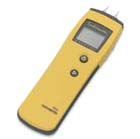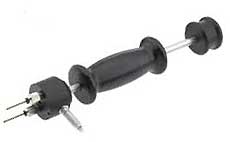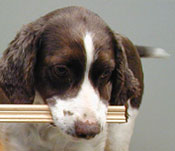Wood Moisture Meter Design
Moisture Meters for Wood come in a
variety of styles.
2 Pin Type Wood Moisture Meter:
This is the traditional type of moisture meter, that has two
pins that are physically pushed into the wood to get an accurate
reading. It is the best moisture meter for taking measurements
on rough wood, where penetration into the wood is the only
way to get an accurate reading (ie. at a sawmill or dry kiln
where you are typically only testing rough lumber). You need
to penetrate approximately 1/4 of the thickness of the wood
to be effective.
There are two basic "pin type" wood moisture meter designs to think about:
- The most basic has pins that are screwed right into the
body of the meter and you must manually force
 the
probes into the wood. It is guaranteed that you will break
the odd pin or two so make sure that they are replaceable
with screw-in type electrodes. This style is somewhat difficult
particularly in dense hardwoods or in awkward locations.
The Protimeter Timbermaster Moisture Meter shown here is
great because it has the ability to use both solid mounted
probes or as discussed below an independently mounted electrode.
the
probes into the wood. It is guaranteed that you will break
the odd pin or two so make sure that they are replaceable
with screw-in type electrodes. This style is somewhat difficult
particularly in dense hardwoods or in awkward locations.
The Protimeter Timbermaster Moisture Meter shown here is
great because it has the ability to use both solid mounted
probes or as discussed below an independently mounted electrode. - A more sophisticated version has pins and meter that are
independently connected via a cable. Thus the
 meter
can sit on the table and a hammer head is independently
connected to the wood moisture meter via a cable. The hammer
head helps in forcing the pins into the wood and in the
more sophisticated models, can be set for depth of penetration.
The pins are typically replaceable and screw into the foot
of the hammer head probe. This is ideal if you wish to leave
the probe and cable in place, say in a kiln and just carry
around the meter when you want to test your wood.
meter
can sit on the table and a hammer head is independently
connected to the wood moisture meter via a cable. The hammer
head helps in forcing the pins into the wood and in the
more sophisticated models, can be set for depth of penetration.
The pins are typically replaceable and screw into the foot
of the hammer head probe. This is ideal if you wish to leave
the probe and cable in place, say in a kiln and just carry
around the meter when you want to test your wood.
Pinless Wood Moisture Meter:
This style is sometimes referred to as a nondestructive probe,
as it does not require surface penetration to work. It uses
sophisticated electronics to measure the amount of water in
the wood. For this reason it is particularly effective for
using as a moisture meter for hardwood
floors or antique furniture. A sensing pad is pressed
down firmly to a smooth wood surface to get a reading over
approximately 2 square inches.. it is fast and easy but not
a good choice if most of your requirement is to meter rough
lumber as it must have good contact between the pad and the
wood surface.
Today, many of the more sophisticated, and thus expense wood moisture meter designs include all of these features.
- replaceable probes mounted on the meter
- exterior jack for attaching an independent probe and hammer head electrode
- a sensing pad for quick easy surface metering.
Thus if you can justify the cost, buy a wood moisture meter that has all three features for maximum use and versatility.
Other Related Content
Wood
Moisture Meter Features
General Discussion of Moisture
Meters: Wood
